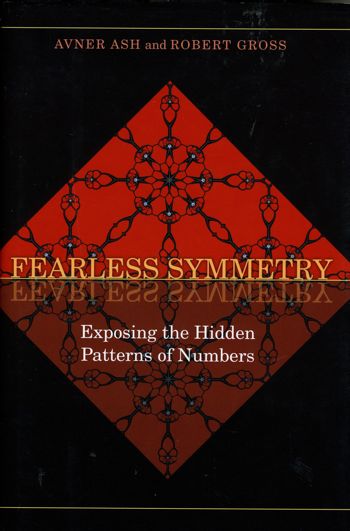It is -8 C with a high forecast of -5 C. Sunrise 8:28 Sunset 16:38 Hours of daylight: 8:10.
See current Lethbridge forecast here. See current Lethbridge news here.
Let me try to summarize my understanding of the first chapter of "Fearless Symmetry" which I read and yellow-highlighted yesterday.
The starting point is the concept of a function. Given 2 sets of objects, a function is a rule that identifies for each and every element in one set the corresponding element in the other set. A morphism is a special type of function that describes some special feature of the two sets. And a representation is a special type of morphism ...
Nope. I am not there yet. |
Chapter 1: Representations
Looking at the book, a representation is a special type of morphism from a source object to a standard target object.
The underlying idea is that since we know something about the standard target object we can then infer something about the source object. For example, if I have a set of 3 people {Peter, Paul, Mary} and I have a morphism which shows a correspondence to the set {1, 2, 3} then I know that the set of people contains 3 people. This is a very abstract and convoluted way of describing something that we take for granted. The concept of a representation is a new one for me. I do not recall seeing that term or idea when I was studying mathematics in the 1960's.
Typing "representation mathematics" into google gives two different types of web sites. One type describes various types of representations (i.e. ways of describing) a mathematical idea such as real numbers, geometric objects, graphs, diagrams, models. The other type describes the idea of a representation as a "branch of mathematics that studies abstract algebraic structures". This latter idea is the one used in the book "Fearless Symmetry" and is one that I am about to learn more about.
Googling "algebraic structure" gives the following wikipedia definition: "In algebra, a branch of pure mathematics, an algebraic structure consists of one or more sets closed under one or more operations, satisfying some axioms." Strangely enough, I understand this sentence.
Returning to the book, I should begin with a definition of a set: A set is a collection of things, called the elements of the set.
A rule is any definite means of association between two sets. A rule may be a list or table that indicates this association, a diagram or sketch (perhaps hand drawn), a formula, a sentence or paragraph.
Here is the sequence of ideas: set, element, rule, function, morphism, representation. This is not hard, but it is abstract and it does require that one pay attention to detail, and that one have a "clear" understanding of what is being said. This clear understanding involves an interplay of verbal definitions and concrete examples. That is, I should be able, at any time, to give a coherent explanation of the idea and I should be able to give a few examples and non-examples of the idea.
Okay, let's try again. Book closed, eyes not straying to what is written above.
A set is a collection of things, called elements.
Examples: 3 sheep, all the people in this room, the numbers 3, 7, 0 and -2
Non-examples: an ill-formed idea, the color red, an action
A rule is clear description of an association between the elements of two sets.
A one-to-one correspondence is a rule that associates each element of one set with exactly one element of the other set.
A function is a rule that describes a one-to-one correspondence.
A morphism is a function that describes some "essential feature" of the source set.
A representation is a morphism from a source set to a special target set.
This book will focus on representations involving groups, and in particular Galois groups. There are other representation theories involving other mathematical objects.
Chapter 2: Groups
- "Mathematical sets can be interesting and easy to define, but very hard to understand in detail." [p. 13]
- "If a set can be endowed with extra structure, it can help our understanding. One very common kind of extra structure is a 'composition law' that turns the set into a group." [p. 13]
- "The definition of a group is the most common way mathematicians have of formalizing the concept of symmetry." [p. 13]
| This is an excellent reason for studying groups - to learn more about symmetry. |
- "The concept of a group is necessary for the representation theory we are developing . All of our objects are groups of one kind or another. There is a lot known about groups in general and about special kinds of groups in particular, and we will be able to deploy all this knowledge when we can impose a group structure on the objects we want to learn about." [p. 13]
- "A group is a set along with a rule that tells how to combine any two elements in the set to get another element in the set. We usually use the word composition to describe the act of combining two elements of the group to get a third." [p. 14]
- "The key point about a group is the combination of any two elements to get a third." [p. 15]
- "A group G is a set with a composition defined on pairs of elements , as long as three axioms hold true:
- There is a neutral element e in G, so that x o e = e o x = x, no matter what element of the group is substituted for x
- For any element x of G, there is some element y in G so that x o y = y o x = e (inverse element)
- For any three elements x, y, and z in G, we have (x o y) o z = x o (y o z). (associative law) [p. 17]
- "A group that has infinitesimal generators is called a continuous group. ... This is the germ of the theory of Lie groups and Lie algebras, named for the Norwegian mathematician Sophus Lie (pronounced 'lee'). Examples of Lie groups include the set of rigid motions of space to itself, ... the set of rotations of a circle ... " [p. 19]
- "An example of a discrete group is the set of integers, where we 'compose' two integers by adding them together." [p. 19]
I am somewhat familiar with the concept of a group, but have not studied the topic for 40 years.
One problem with the present introduction is that there is no hint of how the idea of group first came into being. That may be rectified later in the book, when we meet Galois (which I assume we will as we will be discussing Galois groups). I am not sure if this has much to do with solving algebraic equations of degree 5. |
Tags: mathematics, symmetry, representation, group theory




